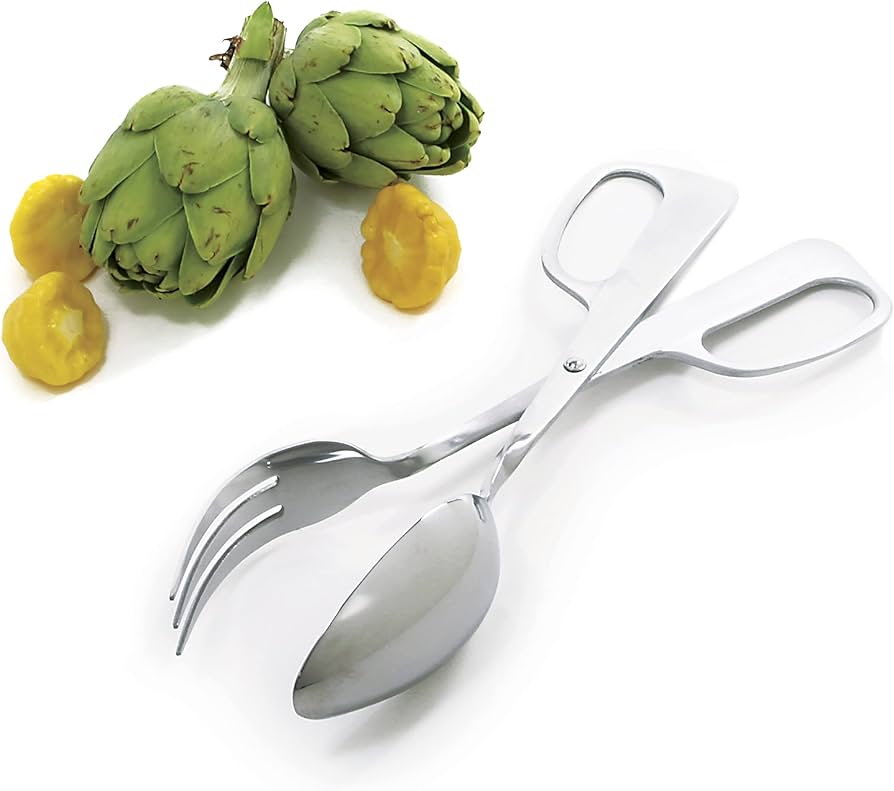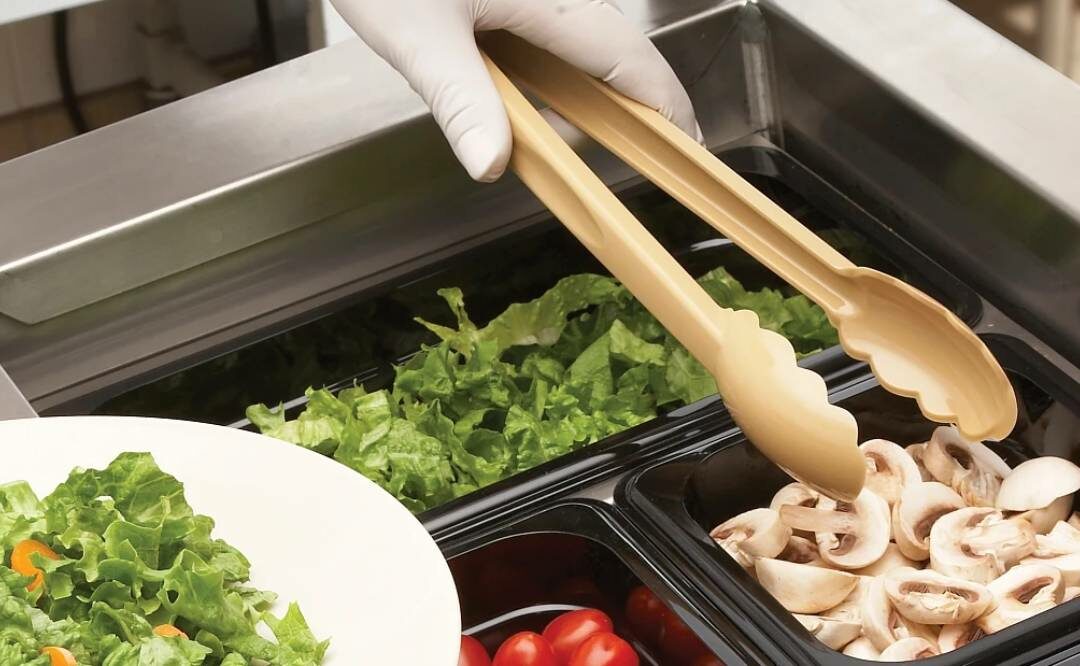At first glance, tongs may seem like simple grab-and-hold tools. But there’s an incredible variety of specialized tongs designed to help you excel at different culinary tasks. From flipping burgers on the grill to delicately handling pastries, having the proper tongs can make all the difference.
This comprehensive guide will give you the knowledge you need to select the perfect pair of tongs for any job.
Tongs for Baked Goods
Pastry tongs, featuring wide, flat ends with a slight bend, are designed for the gentle handling of delicate tarts, scones, flaky pastries, and more.
They excel at transferring pastries between surfaces like your work surface, baking sheet, cooling rack, or plate. These tongs are also best at maneuvering cakes and flans from display case into a box for customers’ takeaway. This gentle touch makes them also ideal for flipping cookies mid-bake, arranging pastries for display, and even adding delicate decorations without damaging the flakiest creations.
With their wide, flat ends designed for a gentle yet secure grip, bread tongs are ideal for handling all sorts of breads, from delicate brioche to crusty baguettes. Unlike pastry tongs, they can handle sturdier varieties without crushing them. Use them for serving breads, arranging bread baskets, or assembling sandwiches.
Designed specifically for toast, these tongs typically feature one or two flat ends to securely grip the toast so it won’t slip, while making sure that the toast is not damaged.


Multipurpose Tongs
A versatile utensil that combines a flat, spoon-like end for scooping up loose or saucy foods (like rice, potato salad, macaroni and cheese), with a notched end that grips and picks up solid foods securely (like bread rolls, sliced meats, vegetables). This two-in-one design makes them ideal for places that offer a variety of dishes at self-serve stations.
Cooking And Serving 2-In-1 Tongs
They are designed to be your one-stop shop for cooking and serving. Made with high-heat resistant materials, they can handle anything you throw at them in the kitchen. The basic design boasts slotted spatula ends on both sides, perfect for flipping and serving delicate fish, vegetables, and meats.
Then we have the “Clong” tongs. Clongs are innovative tongs that feature a click-lock mechanism for easy opening and closing, similar to a retractable pen. They also have a clever bend in their handles to sit them up off the bench, which can also be used to rest them on the edge of your pan.
The smaller Clongs are perfect for stirring noodles, flipping sausages, and transferring food from pan to plate. For the BBQ grill master, a larger, heavy-duty version boasts a flat tip for scraping the grill clean, a sausage pricker, a built-in cutter for separating links, and even waffle-shaped grips for grabbing the tiniest onion pieces. Talk about multi-functional!

Specialty Tongs
These tongs are all about those slippery noodles! Their teeth-like ends make it easy to pick up and drain excess liquid from even the most tangled pasta, making sure portions are neatly lifted and presented without any strands slipping away.
Often used with ice buckets, these are long grabbers that keep your hands dry, thanks to the long handle and the grippy bit at the end that hold on to the ice cubes. Made of tough materials like metal, you’ll find them in kitchens and bars to help you add ice to drinks without getting messy.
Serving tongs are usually shorter than other tongs. This makes them easier to handle on a crowded table or buffet line.
When designed with a spoon on one end and a fork on the other, these serving tongs blend the scooping and lifting features of a spoon with the piercing and gripping strength of a fork. They excel in serving salads: the spoon gathers greens and dressing, while the fork easily grabs larger items like croutons or vegetables. When serving fish, the spoon delicately supports fish fillets, while the fork ensures they stay secure. They’re also handy for dishes like stews with meat and veggies or stir-fries.
These tongs are designed with a perforated shovel on one side and a closed one on the other. The perforated side allows for efficient draining, while the closed side is ideal for securely holding sauces or liquids, so the diners won’t end up with way too much sauce and just a little veggie.
Beyond the Grip: Material Matters
Stainless steel tongs are a popular choice for kitchen utensils. Let’s explore the pros and cons of this material.
Pros:
- Durability: It’s a robust metal alloy that can withstand regular use and heavy lifting without bending or breaking. This makes them ideal for tasks like grilling hot and heavy food items.
- Rust and corrosion resistance: Stainless steel’s chromium content forms a protective oxide layer that prevents rust and corrosion. This ensures the tongs stay hygienic and last for a long time, even with frequent exposure to moisture and heat during cooking.
- Heat resistance: With good heat tolerance, you can safely handle hot food without the tongs warping or melting. This is crucial for tasks like searing meat or flipping food on a hot pan.
- Easy cleaning: Stainless steel has a smooth, non-porous surface that makes them easy to clean. Food residue doesn’t stick easily, and they are dishwasher safe.
Cons:
- Heat transfer: Since stainless steel can handle heat, it’s also a good conductor. This means the handles can get hot if you’re using them for extended periods over high heat, potentially burning your hands.
- Scratching non-stick surfaces: Stainless steel can damage the non-stick coatings over time. That’s why some tongs come with a silicone tip to make them safe for use on non-stick pans.
Polycarbonate tongs bring a lot to the table—literally. They offer a unique blend of features that make them a popular choice in the kitchen. Let’s explore its pros and cons.
Pros:
- Lightweight: this makes them easy to handle and manipulate, especially for extended periods.
- Heat resistance: they can withstand high temperatures without melting or warping, making them suitable for use in hot cooking environments.
- Non-reactive: Polycarbonate is non-reactive with food, this ensures that there is no transfer of flavours or odours during use.
- Wallet-friendly: Polycarbonate tongs are often more affordable than tongs made from other materials.
Cons:
- Durability: While polycarbonate is durable to a certain extent, it may not be as long-lasting as stainless steel.
- Limited uses: Polycarbonate tongs may be more prone to breakage or damage when used for heavy-duty tasks.




Resist the urge to stick to one pair of tongs for everything. While it might seem convenient, it can lead to frustration at times. Imagine struggling to flip a delicate fish fillet with bulky tongs instead of using a dedicated pair designed for easy maneuvering. Take stock of the foods you regularly cook and invest in specialized tongs for them. With a few key pairs, you’ll unlock your kitchen’s full potential!

